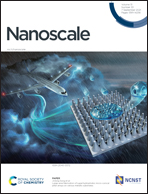Tunable electron and hole injection channels at plasmonic Al–TiO2 interfaces†
Abstract
Metallic nanostructures can strongly absorb light through their plasmon excitations, whose nonradiative decay generates hot electron–hole pairs. When the metallic nanostructure is interfaced with a semiconductor, the spatial separation of hot carriers plays the central and decisive roles in photovoltaic and photocatalytic applications. In recent years, free-electron metals like Al have attracted tremendous attentions due to the much higher plasmon frequencies that could extend to the ultraviolet regime. Here, the plasmon excitations and charge separations at the Al–TiO2 interfaces have been investigated using quantum-mechanical calculations, where the atomic structures and electronic dynamics are all treated from first-principles. It is found that the high-frequency plasmon of Al produces abundant and broad-band hot-carrier distributions, where the electron–hole symmetry is broken by the presence of the semiconductor band gap. Such an asymmetric hot-carrier distribution provides two competing channels, which can be controlled either by tuning the laser frequency, or by harnessing the plasmon frequency through the geometry and shape of the metallic nanostructure. Our study suggests that the Al plasmon offers a versatile and tunable pathway for the charge transfer and separation, and has general implications in plasmon-assisted photovoltaics and photocatalysis.



 Please wait while we load your content...
Please wait while we load your content...